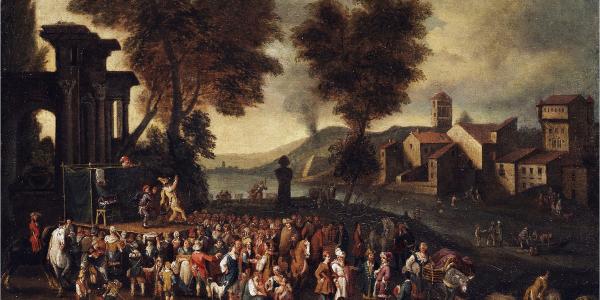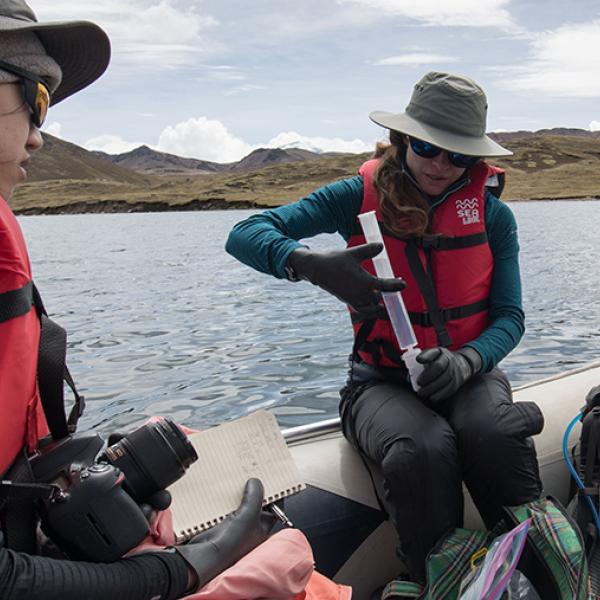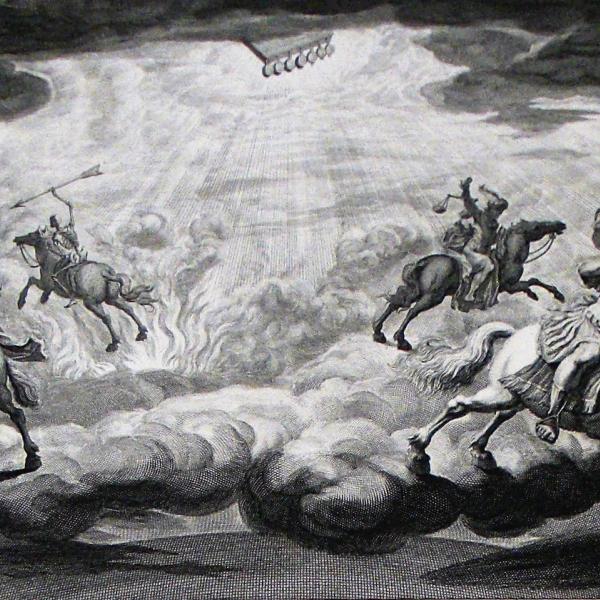Shakespeare drew inspiration from a variety of sources. Robert Henke, a professor of drama and comparative literature at Washington University in St. Louis, studies the Bard in the European context and particularly his Italian sources and influences. He reveals the fingerprints of the famous Italian theater troupe, the Commedia dell'Arte, in Shakespeare's comedies and discusses the Italian plays and novellas at the heart of Romeo and Juliet and The Taming of the Shrew.
Transcript:
Rebecca King: Hey there, listeners! Thanks for tuning in to Hold That Thought. I’m Rebecca King, and today, as we continue our summer with the Bard, we’re looking at some of his Italian influences with our guest.
Rob Henke: I’m Rob Henke. I’m a professor of drama and comparative literature. I’ve been at Washington University for 24 years.
RK: Professor Henke is the author of several books, including Pastoral Transformations: Italian Tragicomedy and Shakespeare’s Late Plays, Performance and Literature in the Commedia dell’Arte, and Property and Charity in Early Modern Theatre and Performance, which is due out the summer from the University of Iowa press. Professor Henke says that Italian theatre has clear fingerprints in Shakespeare’s work.
RH: Early modern theatre really was an international phenomenon. Shakespeare at the Stratford Grammar School was steeped in Roman classics, and you probably know that ten or eleven of his plays are set in Italy. Italy was the vanguard of culture, and it was prestigious not only in lyric poetry. Now Italian renaissance theatre is not as famous as Italian epic and other forms of Italian literature are, but Italian theatre was considered just as important as its other genres. It was tremendously influential. There were writers like—Machiavelli himself wrote plays, Ariosto. The English were heavily influence by the Italian plays, and then there was the commedia dell’arte, which was the professional theatre in Italy. They were a traveling, an itinerant for of the theatre, and they traveled to all points of the compass. They traveled to Germany, to France, to England, to Spain, even to Poland, to the Czech lands. commedia dell’arte took this kind of scripted Italian drama and took it on the road, and they figured out a brilliant system of improvisation that allowed them to perform different versions of the same or similar plays.
RK: And while Shakespeare is clearly aware of and influenced by these Italian authors, he also knew and studied the famous commedia dell’arte, says Professor Henke.
RH: There’s a speech in his As You Like It. A character named Jacques talks about the seven ages of man, and about four of them are based on commedia dell’arte types: the lean and slippery pantaloons is the next to last old man character in the commedia dell’arte.
RK: Henke says that Shakespeare was also influenced by the structure of Italian theatre, including the form of the tragicomedy.
RH: I earlier wrote a book on the form of tragicomedy in Shakespeare’s late plays: Cymbeline, A Winter’s Tale, and The Tempest. Tragicomedy was a new genre that was formalized and codified in Italy. There were both courtly and erudite versions of it, and there was also popular commedia dell’arte versions of it. The whole idea is that you move from tragedy to comedy in a pastoral arena. You use the countryside and the idea of pastoral and the figure of the shepherd as a hinge from darkness and death and destruction and all the things we associate with tragedy to a felicitous turn.
RK: When looking at specific Shakespearian plays, Henke can identify several important Italian influences, including in one of Shakespeare’s most popular works, Romeo and Juliette. He says that few people have considered the Italian sources before in this work, because it is absolutely certain that Shakespeare’s main source for the play was a 1562 English poem titled “The Tragical History of Romeus and Juliette” by a man named Arthur Brook. However, Brook, he said, was translating and adapting from a French translation of an Italian novella, and Henke is convinced Shakespeare was also looking at the Italian versions as well.
RH: I believe that Shakespeare knew the Italians as well. I believe that Shakespeare was actually in the course of learning Italian throughout the 1590s. We all remember in Shakespeare’s Romeo and Juliette, Romeo, who has been to the ball, comes to Juliette’s garden and approaches her balcony, but he stops and he listens to her speak. It’s when she gives her famous “What’s in a Name” speech, and Romeo is listening all that time. Juliette is not aware that he is there. It’s only after about 20 lines or so that he declares himself, and she is shocked. She calls him this rude intruder and so forth. Well, it’s not in Brook. In the English source for Shakespeare, they see each other right away, and they start speaking. It’s in Luigi Groto’s novella version that we have this theme of Romeo listening to Juliette well before he shows himself.
RK: But there are differences, too. For one thing, the Italian version is much more political.
RH: There’s a real important political and civic dimension to Shakespeare’s Romeo and Juliette, but it’s a little bit attenuated. If you go back to the Italian sources, they are more political. It is set in the time of Bartolomeo della Scala, the prince of Verona from 1301 to 1304, and he was famously the person who was hospitable to the exiled Dante. In fact, the first time the Montagues and the Capulets are put together is by Dante in the Purgatorio. They are actually from different towns, but Dante lumps them together as examples of feuding families. For Dante, he’s talking about factionalism and the need for a strong leader to control the factionalism, and the prince in Grotto is stronger than the one in Shakespeare. There is a persistent kind of public and civic dimension to it. Juliette gets this idea; she’s not quite sure whether to pursue this Romeo guy, but one thing that swings it in his favor is she thinks—and this is probably just rationalizing. I mean, she’s in love with him. She’s going to do it anyways. But she says, “Well, maybe this will help bring our families together. Maybe this can play a civic role.” And the friar is a really fascinating figure in the Italians; he’s a great experimenter, he’s a philosopher, he’s traveled all over Europe, and he’s trying to use this relationship to heal. He’s trying to play the role of a peacemaker.
RK: Although Romeo and Juliette is of course a famous tragedy, Professor Henke says it was very influenced by the Italian tragicomedy. It’s sad ending turns on a single moment. In fact, some scholars have even wondered if Romeo and Juliette was itself once a tragicomedy that was later revised to a tragic end. Certainly, theatre companies in the day performed different versions of the story with happy and sad endings.
RH: You take any moment in Shakespeare’s Romeo and Juliette, and the tale can turn different ways. In fat, there’s even a commedia dell’arte version. It’s Romeo and Juliette story where it actually turns out happily, because it is so close to succeeding. All that has to happen is the letter has to get to Romeo from the Friar explaining what’s going on. If the letter gets to Romeo just a little bit sooner, it is a serious play, but it is a tragicomedy; it ends happily.
RK: The Taming of the Shrew is another play with a clear Italian source, says Henke, though notably, it’s source is an Italian play, not a novella.
RH: There are a lot of Shakespeare plays that have Italian novellas as their source: Othello and Cymbeline and others. But the subplot of The Taming of the Shrew is based on a very famous play by Ariosto written in 1508 called I Suppositi, which was translated by a an about a generation older that Shakespeare called George Gascoigne in 1566. It was called The Supposes and performed in one of the Inns of Court in London. It’s a great translation; it’s a great play. The joke is it is the first great English comedy, but it is Italian. It’s fantastic. This is the subplot, the plot that revolves around Bianca, the “good daughter,” more docile anyways. So we’ve got an Italian play as a really significant source. It also turns out that the first appearance of the word “pantaloon” in the English language is in Taming of the Shrew. One of the old characters, one of these rivals for Bianca, is called Pantaloon, and he’s old. He’s practically dead. He’s rich and has all this wealth, but he almost has to have this pacemaker. That is an explicit reference to the commedia dell’arte, and there are other commedia figures as well. I mean, the entire structure of Taming of the Shrew: its based on a set of old men and then a set of lovers and then a set of servants—a kind of tripartite hierarchical structure is really the deep structure of the commedia dell’arte. I don’t think all of Shakespeare’s comedies were influenced by the commedia dell’arte. I think it was actually something he was really interested in the early 1590s when The Taming of the Shrew and other comedies were written, and he is maybe less interested in it in the more mature comedies like Twelfth Night and Much Ado which are later towards the turn of the century.
RK: The Taming of the Shrew is also set in Padua, the home of the prestigious university where English men famously went to study. Though Shakespeare never attended, Professor Henke does think that Bard was learning Italian. There are bits of evidence scattered throughout his plays.
RH: I think the way Shakespeare learned Italian was through this figure’s John Florio’s language learning manuals, because John Florio was an Italian protestant refugee from catholic Italy who came to protestant Italy. He tutored many important people in England, and he wrote language-learning manuals that were little dramatic dialogues facing page—Italian on one side, English on the other side—and little quotes from Florio show up in Shakespeare’s plays, including the fourth intertext in Taming of the Shrew. So, what I am trying to do is look at all of these together, and I don’t think Shakespeare really distinguished between the improvised version of Italian theatre and the scripted version. I think he kind of thought of it all as Italian comedy, and Taming of the Shrew perfectly shows this.
RK: Many thanks to Robert Henke, professor of Drama and Comparative Literature at Washington University in St. Louis. And thanks to you, too, for tuning in to Hold That Thought. If you are interested in reading more of Henke’s work, check out his latest book, Poverty and Charity in Early Modern Theatre and Performance from the University of Iowa press. You can find Hold That Thought and all of our archived episodes on Sound Cloud, ITunes, and Stitcher. Subscribe to stay up to date on all of our latest podcasts.
Credits:
Wikimedia Commons: Peeter van Bredael, Commedia dell'arte Scene in an Italian Landscape
Archive.org: DOMENICO SCARLATTI HARPSICHORD BY JOHN SANKEY, Wolfgang Amadeus Mozart sonatas by Gianluca Luisi, Antionio Vivaldi concert by Largo





